If you’re looking for the best telescopes of 2022, then you’ve come to the right place. Our handy guide of the best telescopes is perfect for seasoned astronomers, who want nothing but the best views of deep-sky targets like galaxies and nebulas, as well as beginners trying their hand at skywatching for the first time. You’re guaranteed to find something to suit your needs and since telescope prices can be sky-high, we’ve included models from the most reliable manufacturers to suit all budgets.
Choosing the best telescope for you depends on something vital, what exactly it is you want to observe. Are you looking for a telescope that will show you an abundance of deep-sky objects or do you want to see something a little closer to home, such as the craters of the moon and planets of the solar system, “faint fuzzies” such as the Triangulum Galaxy (Messier 33) and Lagoon Nebula (Messier 8)?
If you’re targeting deep-sky viewing then reflector telescopes are the perfect choice because of their excellent light-gathering prowess. If you’re after views of our solar system though, refractor telescopes are the one for you. Most instruments these days come with tripods, eyepieces and other accessories you need to get set up. Word-of-warning though, different models vary in the time it takes to set them up.
A lot of high-end telescopes come with technology or systems that will allow you to align your telescope with the night sky and your target at the touch of a button. You can usually do this with a smartphone or a hand-held controller and many are compatible with all the tools you’ll need for astrophotography too.
If you want something easier to transport and you’re just trying to get a better look at the night sky, or you’re not quite ready to commit to buying a telescope, we recommend a pair of the best binoculars instead.
Buying a new telescope can come at a high cost so we’ve included today’s best price for all of the best telescopes in this guide. We also have a host of separate articles with the best deals around at the moment. Check out today’s deals on Celestron, Skywatcher, Meade, and Orion models.
We’ve also rounded up the top rated telescopes under $500 along with the very best telescope deals and discounts, whether you’re looking for a refractor, reflector or computerized model for your skywatching needs.
If, on the other hand, you’re looking for an instrument for a young astronomer, be sure to check out our pick of the very best telescopes for kids.
Beginner telescopes
A decent-sized aperture and good quality optics for the price, the Orion GoScope 80 is set up to make astronomy easy for the beginner. You’ll be able to get very good views of the planets and the moon, along with select bright deep-sky targets, despite the narrow field of view. The Orion GoScope 80 also lacks slow motion controls, which makes fine tuning and centering targets a bit of a hassle — skywatchers have to resort to a “point and aim” method, with the help of the EZ Finder II reflex red dot finder.
Also in the box is Starry Night software to help you choose your targets and pinpoint them in the night sky, free lifetime tech support through Orion as well as two three-element 10 mm and 25 mm eyepieces. The supplied accessories offer magnifications of 35x and 17x.
For a beginner’s telescope, the sights were breathtaking and boast clarity and contrast. The surface of the moon and small views of Saturn are particular highlights — and no aggressive color fringing (although there is some) is evident around bright objects in the field of view. A pleasing find given that refractors are predisposed to chromatic aberration, which also supplied very good views of Jupiter and its largest moons: Ganymede, Europa, Callisto and Io.
The Orion SkyMax 90 employs a sturdy desktop mount, which swings along the axes of altitude and azimuth, so skywatchers will need to ensure that they use a sturdy table for steady observations of the night sky. We discovered that slewing is a very smooth process with this telescope, but should you need one, Orion also offer this telescope with a tripod.
Orion has supplied a clear manual that explains how to use the reflector as well as attach and calibrate the EZ Finder II reflex red dot finder. However, given that the telescope comes assembled straight out of the box, it’s unlikely the skywatcher will struggle with assembling and using it. The ultimate “grab-and-go” telescope!
The Orion GoScope 80 is currently out of stock in the U.S. Try this great alternative instead:
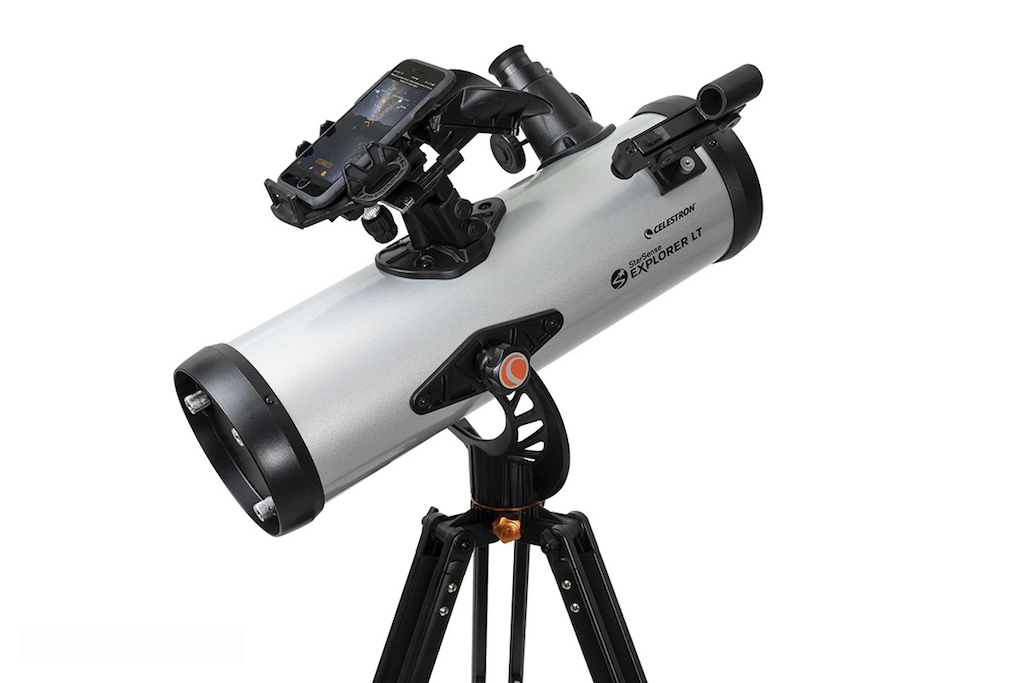
While a great telescope for beginners, the Celestron StarSense Explorer LT 114 can be enjoyed by intermediate skywatchers, too — especially those who want to spend less time setting up and more time observing. Assembly takes less than 20 minutes.
Built into this reflector is Celestron’s StarSense technology, which provides an easy option for aligning the telescope and enables the onboard GoTo system to work out which direction the instrument is pointing. To use the tech, all the skywatcher needs to do is download the StarSense app and take a smartphone image through the eyepiece and the app works out which stars are in the telescope’s field of view to calculate the astronomer’s orientation.
Moving to Jupiter, we made use of the 10 mm eyepiece to view the gas giant. Views are clear, but you’ll need a selection of eyepieces and filters in order to pick out the coloration of the atmospheric bands. The planet’s largest moons are visible as clear, sharp points of light. Views of the moon, Venus and the Beehive Cluster (Messier 44) are also pleasing, with good clarity.
The beauty of the Celestron StarSense series is that you can read up on the literature offered by the app for each target you observe. Slewing from one target to another, we found that the StarSense Explorer LT 114 is a sturdy piece of kit and operates smoothly. One minor drawback is that skywatchers need to manually push the telescope as a motorized mount is not supplied.
With a fair-sized aperture and quality optics typical of Celestron products, you’ll be hard-pressed to find a beginner’s telescope as good and easy to use for the same price.
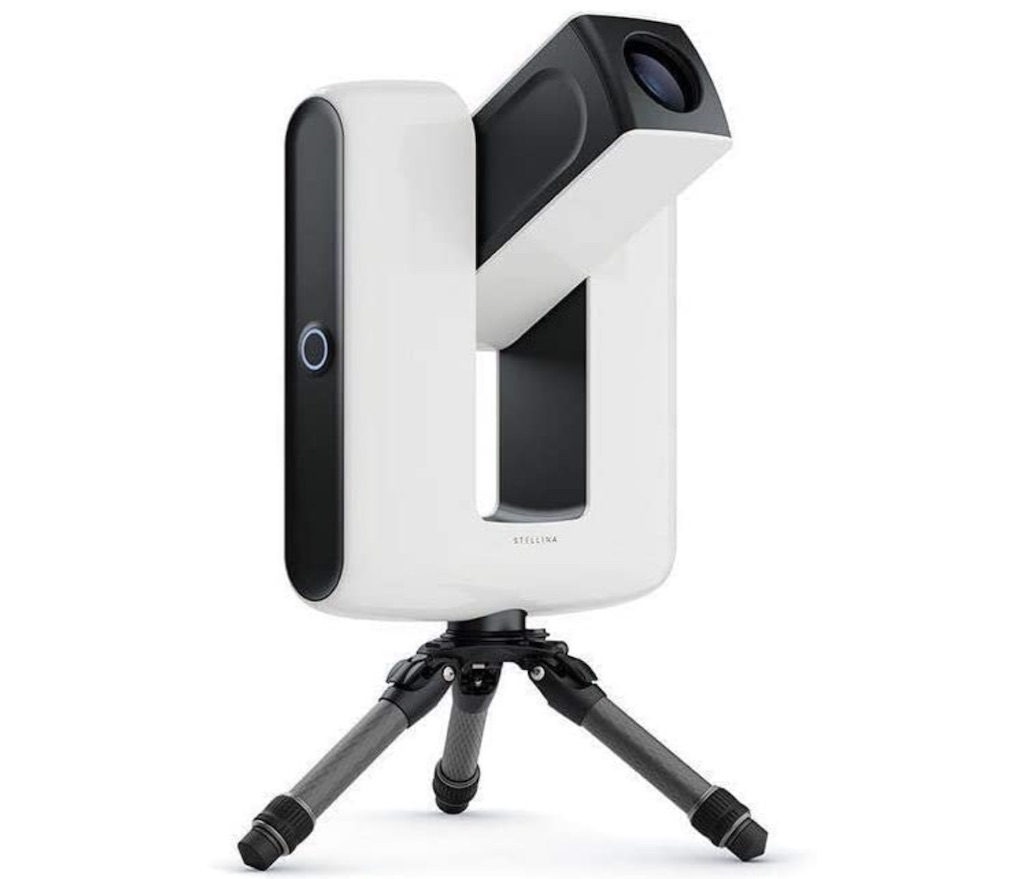
It’s fair to say, that if you’re a beginner, you do not want to be spending precious time assembling your telescope when you could be using those moments for observing. A great beginner’s telescope is one that’s quick and easy to build and calibrate — the Vaonis Stellina is certainly that.
This telescope is unlike anything else on the market: its smart design means that it doesn’t require the use of finderscopes and eyepieces, instead making use of a Sony CMOS (complementary metal-oxide-semiconductor) and smartphone navigation to reveal views and images of the night sky. A free download of the Stellina app is included in the hefty price tag, along with an instruction manual. The database features 100 targets to explore.
Given the wide-angle sights the Stellina offers, this telescope isn’t ideal for studying the planets, although views are fair. Instead, it excels in providing images of bright deep-sky targets and the surface of the moon. Star clusters, select nebulas and galaxies are within easy reach through the optical system and we are, in particular, blown away by views of the Andromeda Galaxy (Messier 31) through this smart telescope. Decent clarity can be had, while 6.4MP images with a resolution of 3096 x 2080 are produced in JPEG and Raw format — the former being a great option to share on social media in Ultra HD.
While more of a telescope for imaging, the Stellina is a fantastic instrument for group observing, allowing users to connect up to ten smartphones or tablets. It features a built-in light pollution filter, offers astoundingly precise tracking and adapts well to changes in weather conditions. It’s pricey, but for the sophisticated technology and sturdy build, we expect no less.
It looks like the Vaonis Stellina is out of stock in the U.K. Try this great alternative instead:
Best telescopes for enthusiasts
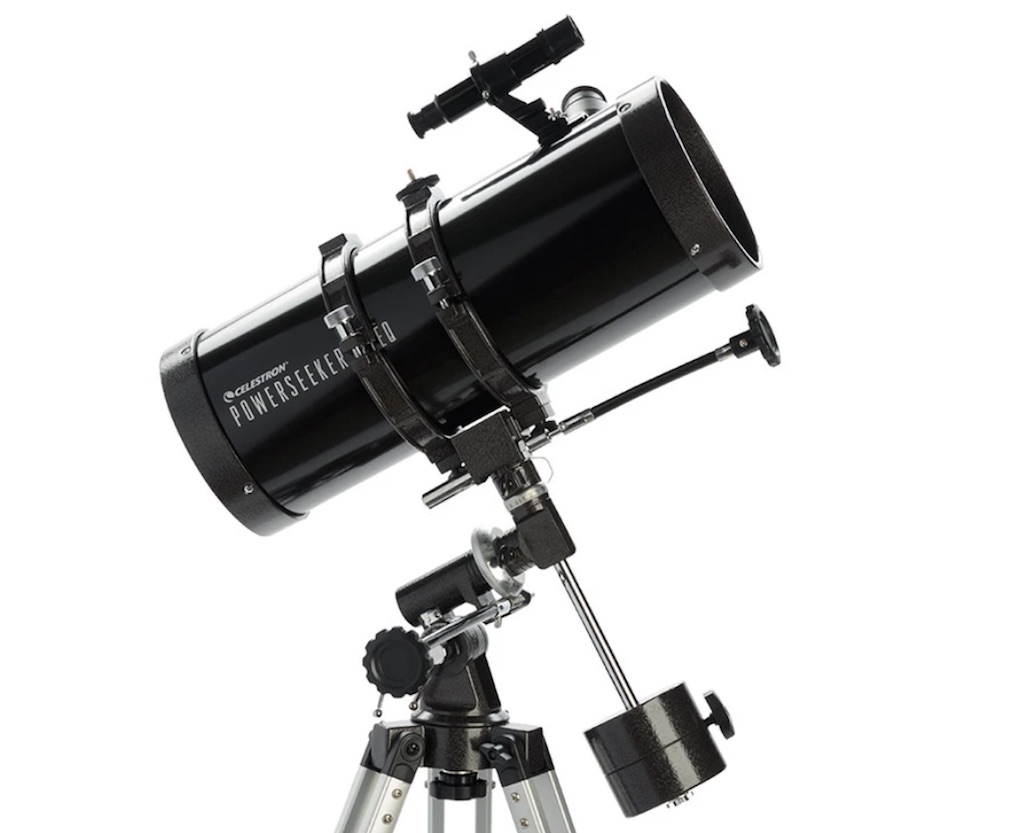
This great package from Celestron features a five-inch (127 mm) aperture telescope at a competitive price, making it perfect for those hunting for an instrument that allows the skywatcher to dabble in observing the solar system and deep-sky targets without investing a great amount of money.
The Celestron PowerSeeker 127 EQ comes with two eyepieces: a 20 mm and 4mm, which work with the optical system to produce magnifications of 50x and 250x. There’s also a 3x Barlow lens for tripling the magnification on the eyepieces, though truth be told it really isn’t needed — the maximum magnification that the telescope is able to achieve is 300x, so using the Barlow with the 4 mm eyepiece, for example, causes images to become blurred.
With most budget telescopes these accessories aren’t of the highest quality, so it’s recommended that you replace all these with your own selection of eyepieces and Barlow lenses, while being mindful of the PowerSeeker 127 EQ’s optical limits.
Skywatchers will need to be comfortable with using an equatorial mount, the slow-motion controls and have polar aligning knowhow before considering the PowerSeeker 127 EQ. Once they are, this reflector serves as a reliable instrument for observing — and more so if the observer collimates the mirrors regularly. Once this is achieved, the optical system offers impressive celestial sights.
The manual equatorial mount is simple and does the job, but the aluminum tripod is a little shaky so we recommend steadying the instrument during your observations. For the money, however, the flaws with this reflector are minor given the low price point.
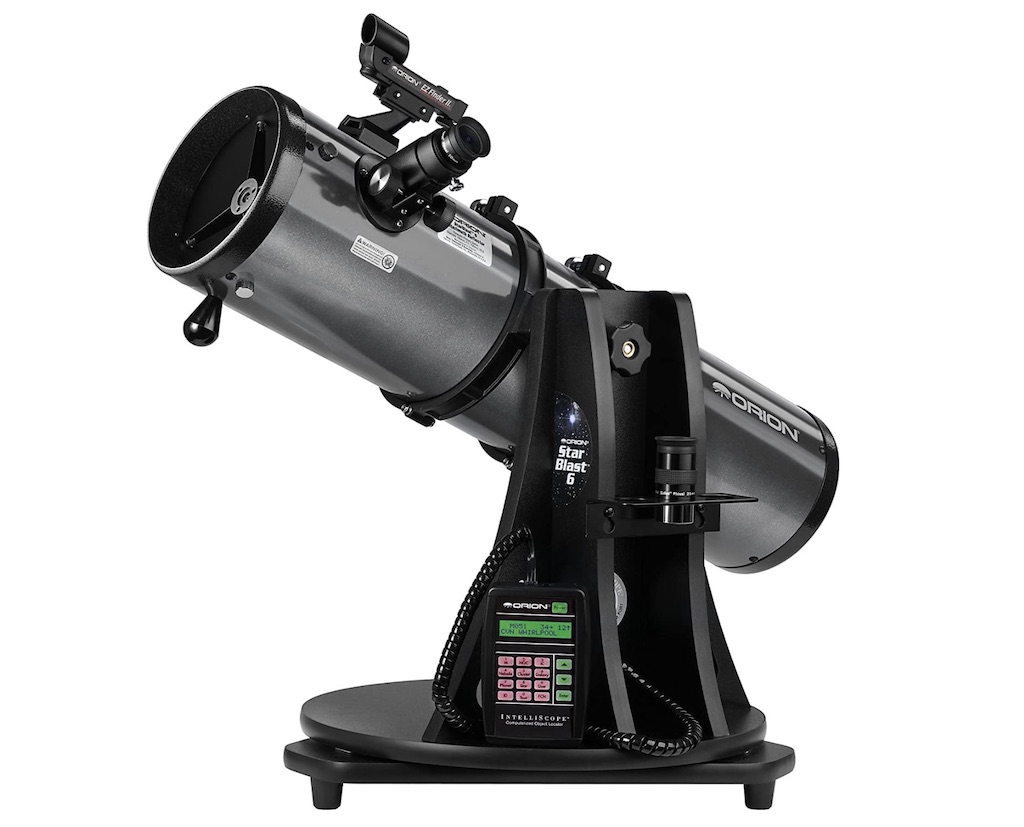
More and more telescopes are making use of computerized mounts for a fuss-free tour of the universe and Orion’s StarBlast 6i IntelliScope is one such telescope and mount combination. The 5.91-inch (150 mm) reflector comes preassembled out of the box, while a simple star alignment process means that you’re observing within minutes.
The Orion StarBlast 6i IntelliScope makes use of a couple of high-resolution digital encoders, which help the skywatcher to locate and identify objects in the night sky. This portable telescope doesn’t operate quite like your standard GoTo, where the mount slews to the observer’s chosen target. Instead, the user needs to manually push the tube and with the guidance of directional arrows on the supplied Computerized Object Locator’s (COL) backlit display. There are a little over 14,000 targets to explore, and we found that we were able to push the tube smoothly from one target to another.
When it came to observing with the telescope, the optics stood up pretty well under a night sky tinged with a touch of light pollution. The rings of Saturn, the rugged surface of the moon and the atmospheric bands of Jupiter stood out particularly well, with no major optical distortion or defects visible. Observations through the field of view are pin-sharp, with a selection of wispy nebulas and bright galaxies such as the Pinwheel Galaxy (Messier 101) in Ursa Major within reach of the modest aperture. A good amount of the targets listed within the COL’s database, are observable through this light guzzler but be aware that you’ll need further accessories to make the most of the optical system.
The Orion StarBlast 6i IntelliScope is quite well equipped, supplied with 25 mm and 10 mm Plössl eyepieces, collimation cap, accessory rack, a Starry Night software download card and an EZ Finder II reflex sight finderscope. The latter of which held up well when moving between very low magnitude stars.
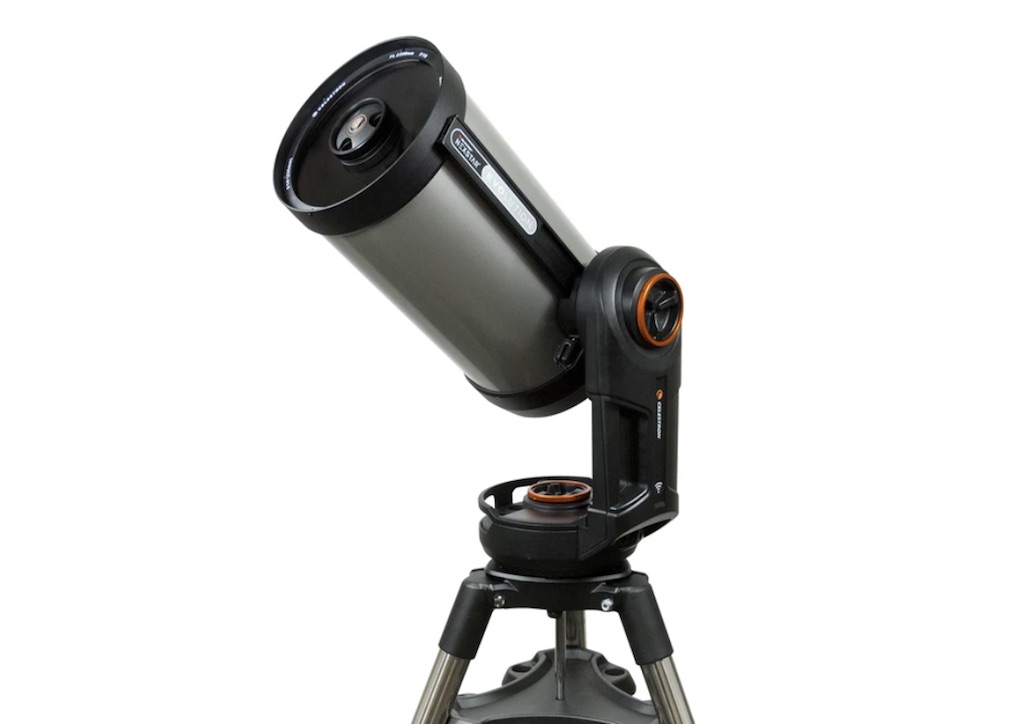
The optical system of the Celestron NexStar Evolution 9.25 ranks as one of the best we’ve ever had the pleasure of observing the night sky through. With no interference or optical defects in the field of view, this high-quality instrument offers sights of a wide selection of astronomical targets with impressive clarity and contrast.
Supplied with the setup is a red dot finderscope, two eyepieces — a 13 mm and 40 mm — and an international AC adapter, an attachable camera and hand control for a seamless AutoAlign process.
The NexStar Evolution 9.25’s single-fork arm is the pride of the instrument, allowing the observer to slew from one target to another at the touch of a button and powered by a rechargeable lithium-ion battery for around 10 hours of continuous observation on a good run.
Built into the mount is the telescope’s very own Wi-Fi network, allowing the instrument to connect and control via the Celestron SkyPortal app (downloadable for free on iOS and Android). Being motorized, the mount is capable of tracking objects as they move across the sky, making the NexStar Evolution 9.25 a must-try for astrophotography.
If you’re looking for a complete high-definition tour of the universe, then we fully recommend this GoTo to seasoned skywatchers with decent budgets. The only downside is that the NexStar Evolution 9.25 is tricky to transport due to its weight, meaning that skywatchers will take this into account before planning any trips beyond the backyard — a small trade-off given the telescope’s robust and high-quality design.
It looks like the Celestron NexStar Evolution 8 is out of stock in the U.S. Try this great alternative instead:
Best Computerized or GoTo telescopes
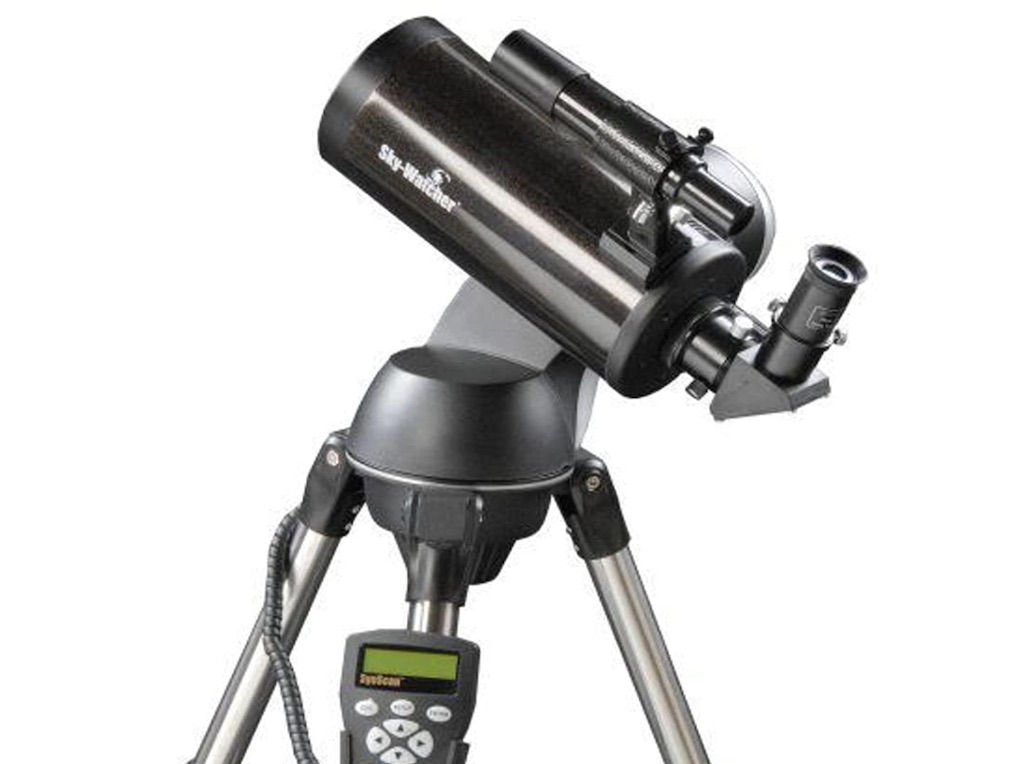
As an introduction to the world of GoTo skywatching, the Sky-Watcher Skymax 127 SynScan AZ is a must-have for observers on a limited budget. The SynScan AZ hand controller offers information on over 40,000 astronomical objects, which includes the most complete catalogs (Messier, NGC, IC and SAO) of deep-sky and solar system targets, while the astronomer is supplied with everything they need for a successful night: reasonable quality star diagonal, 2x Barlow with a camera adaptor, 6×30 finderscope, stainless steel tripod and accessory tray.
Assembling the instrument is easy and, given the weight of 39.7 lbs. (18 kilograms), the Sky-Watcher Skymax 127 SynScan AZ is light enough to carry across the backyard without a great deal of effort. Skywatchers have the choice of powering the Servo Drive with 8 AA batteries or a 12V power supply — with batteries having a tendency to drain quickly in cold conditions, we recommend investing in the latter for uninterrupted observations with the SynScan technology. Alignment is a breeze, making use of two stars to set the instrument up, but beginners may need practice in getting this just right — we recommend becoming acquainted with the Skymax 127 during daylight hours, while ensuring that you read the supplied manual from cover to cover.
In terms of optical prowess, we don’t have any complaints — especially given what’s offered in the telescope’s package. We can fit a waxing gibbous moon phase in the field of view and, after tweaking the focuser, the craters and lunar mare are brought into exquisite focus, contrast and clarity. A moon filter offered even better sights. Slewing over to star-forming region, the Orion Nebula (Messier 42), is also picked out with ease with the 5-inch (127 mm) aperture — it appears as a dusty patch of light with the Trapezium Cluster’s member stars dazzling with brilliant clarity at the nebula’s heart.
A minor niggle is the shaky stainless steel tripod, so we recommend supporting the setup by hand while slewing and in windy conditions.
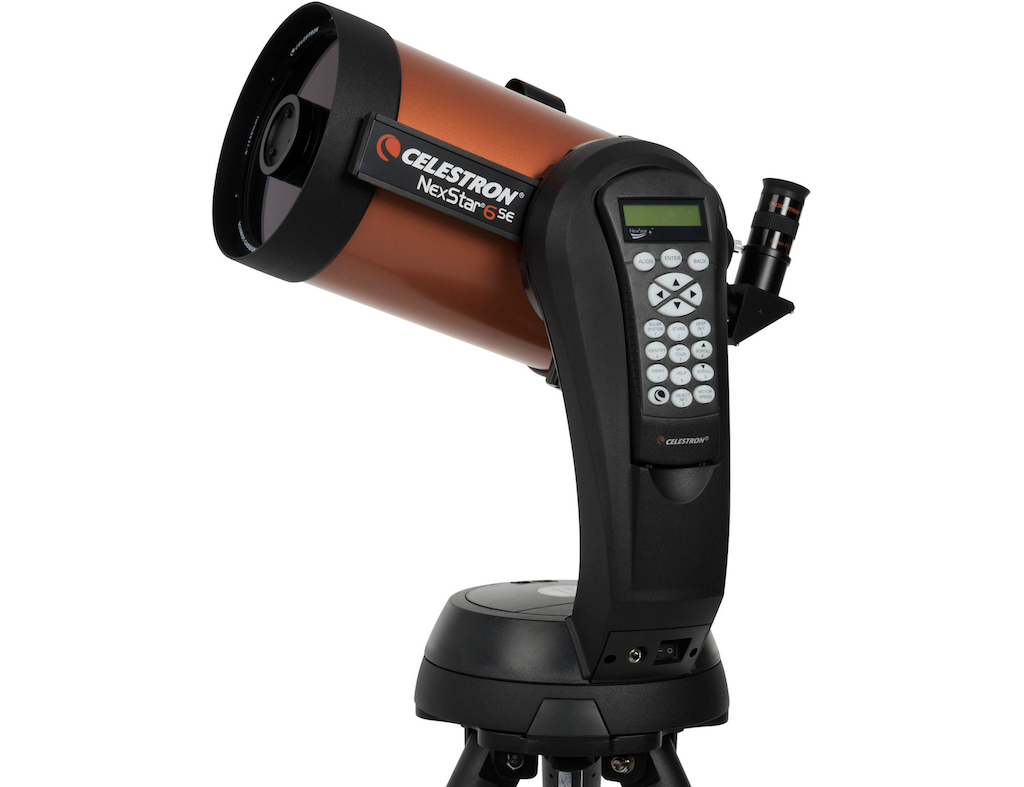
Celestron’s range of NexStar telescopes have a well-deserved reputation for great optics, user-friendly assembly and a plethora of features, and the Celestron NexStar 6SE exemplifies all of these.
The 5.91-inch (150 mm) aperture is a step up from the Meade StarNavigator NG 114 in terms of light-gathering prowess, while the more than 40,000 astronomical objects in the NexStar+ hand controller’s database means you’ll never run out of new targets to seek. However, skywatchers should be mindful that extra eyepieces will need to be added to capture them and, even then, the aperture won’t show all targets listed in the database in great amounts detail.
The NexStar 6SE offers a tour mode, where the telescope will guide you to carefully chosen targets, whether in a particular constellation or across the sky — a fantastic feature if you can’t decide which objects to observe or want to explore night-sky treasures you’ve never seen before.
The SkyAlign technology, which is a breeze to use, gets you pointed in the right direction fast, while the motorized mount has nine slewing speeds as well as sidereal, solar and lunar tracking rates. Be warned though: with such impressive technology, the NexStar 6SE drains batteries quickly, so we recommend powering the setup with an external power source.
Imagers may initially be displeased with its slow f/10 focal ratio, limiting the NexStar 6SE to being a planetary or lunar imager at best, but there is the facility for more advanced users to switch out the secondary mirror for their camera, with the smaller light path increasing the focal ratio to an astrophotography-friendly f/2.
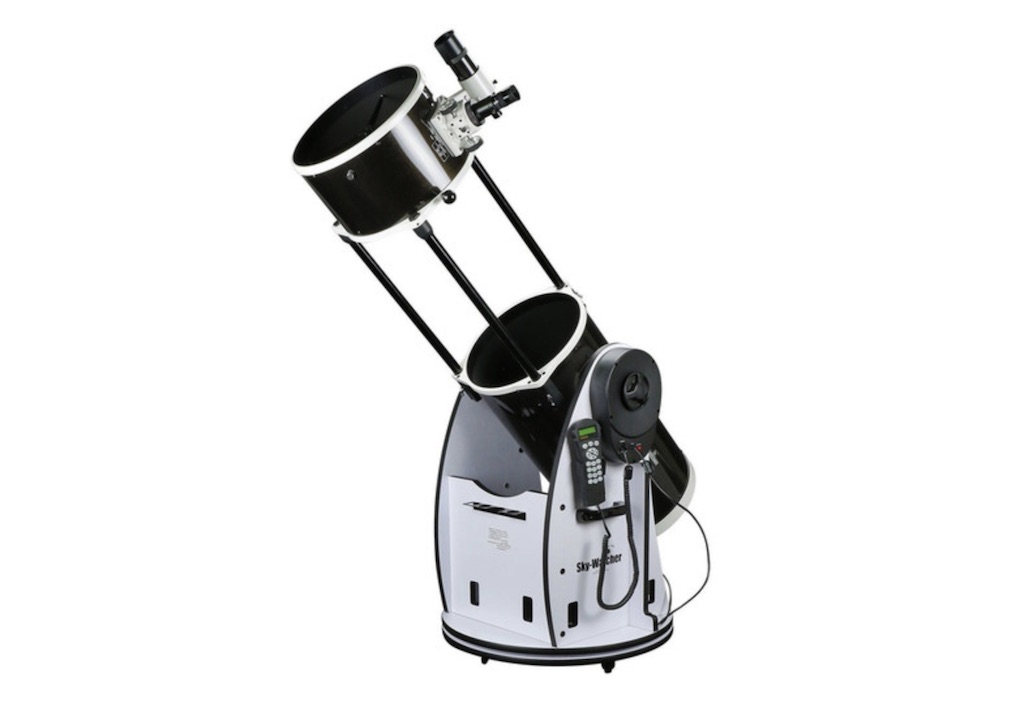
The larger the aperture of your telescope, the more light it will gather, allowing you to resolve the finer details in astronomical objects, and see deeper into the universe. With a 12-inch (305 mm) objective, this collapsible Dobsonian from Sky-Watcher lives up to the tag of “light bucket”.
Dobsonians are designed for their simplicity and, with its GoTo capability plus motorized rocker alt-azimuth mount navigated by a SynScan hand controller, getting great views of the night sky and calibrating the telescope has never been easier.
Over 40,000 targets are offered in the database and, we have to say, that seeking out faint fuzzies was our first port of call with the Sky-Watcher Flextube 300 SynScan. The Andromeda Galaxy (Messier 31) is an incredible sight, with some dust lanes visible and the bulge glowing brightly. Its satellite galaxies are also visible as points of light in the field view.
With a focal ratio of f/4.9, this Dobsonian is fast enough for imagers to make use of all the photons that it will collect. With a little skill, you’ll be able to take some amazing images through this telescope.
Although the Sky-Watcher Flextube 300 SynScan is heavy, its collapsible design makes it easier for you to fit in the trunk of your car whenever the need arises to seek out dark-sky parks or attend star parties.
It has a hefty price tag, but given the aperture, imaging prowess and GoTo capability of the Sky-Watcher Flextube 300 SynScan, it’s a must-buy for hobbyists.
The Sky-Watcher Flextube 300 Synscan Dobsonian is currently out of stock in the U.K. Try these great alternatives instead:
Best telescopes for observing planets
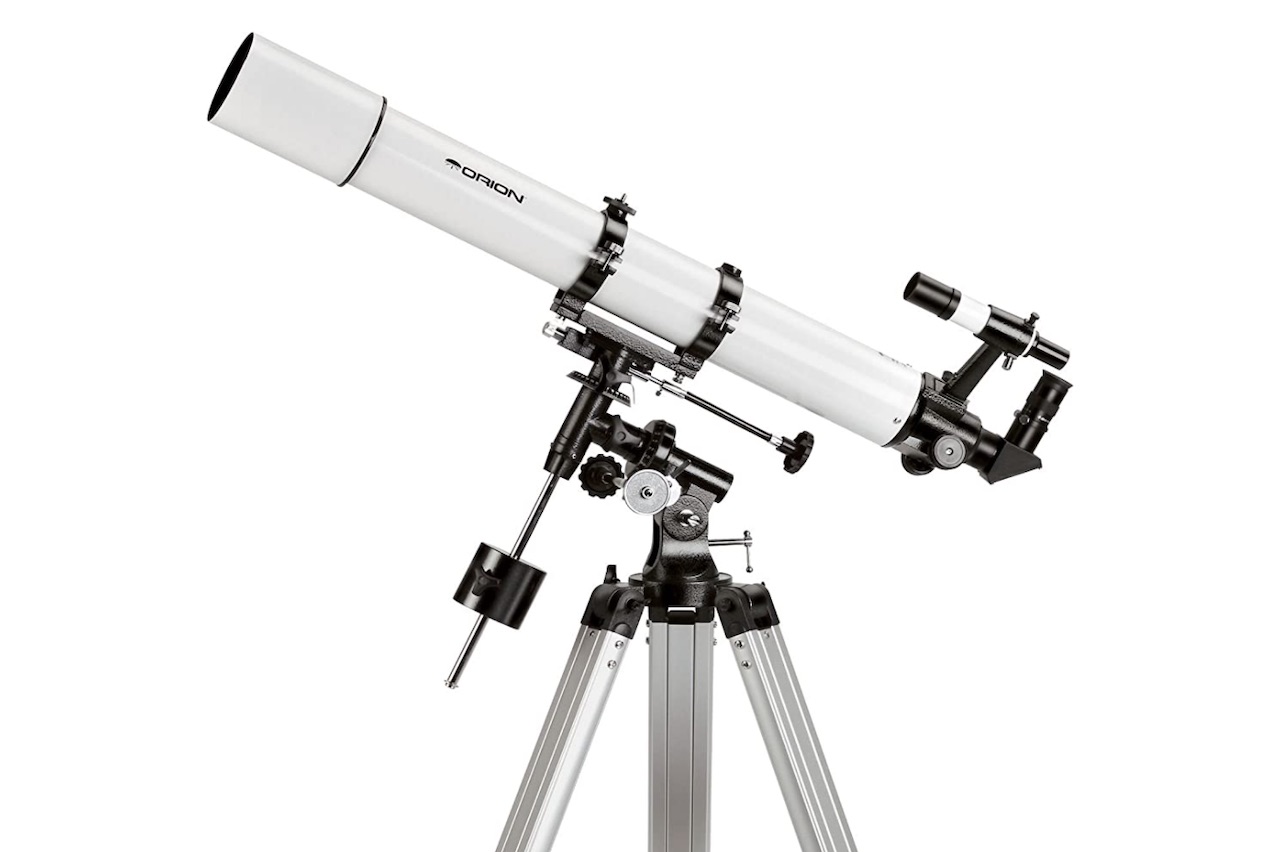
Orion describes the AstroView 90 as a “planetary power-performer”, and for the price and aperture, this refractor passes muster. Supplied with accessories, a simple equatorial mount and tripod, the instrument comes with everything you need for good views of the night sky. The tripod isn’t the highest of quality but for the price, it certainly does the job.
The views of Jupiter with its belts and moons, Saturn and its rings and, with the right eyepieces, even the tiny blue-turquoise disks of faraway Uranus and Neptune all snap into clear view. The Orion AstroView 90 also shows the main surface features of Mars, when the Red Planet is at opposition and at its best for observing, as well as Mercury and the phases of Venus. A slight amount of false color is visible but expected from a telescope at this price point — our sights are not spoiled by this optical defect.
Naturally, the moon is also breathtaking through the optical system with craters Copernicus and Tycho during the first quarter moon phases being a highlight: views are pin-sharp with plenty of contrast. Although it is heralded as a planetary performer, the AstroView 90 can also reveal some of the brighter deep-sky objects, too. Magnified views of the Pleiades star cluster (Messier 45) in Taurus are breathtaking and a must for skywatchers peering through this instrument.
The supplied eyepieces are of reasonable quality, though as with all budget telescopes, you may want to purchase separate higher-quality accessories to get an even better look at the moon’s impacts — we also recommend a 2x Barlow lens to double the magnification, while being mindful of the AstroView 90’s optical limits.
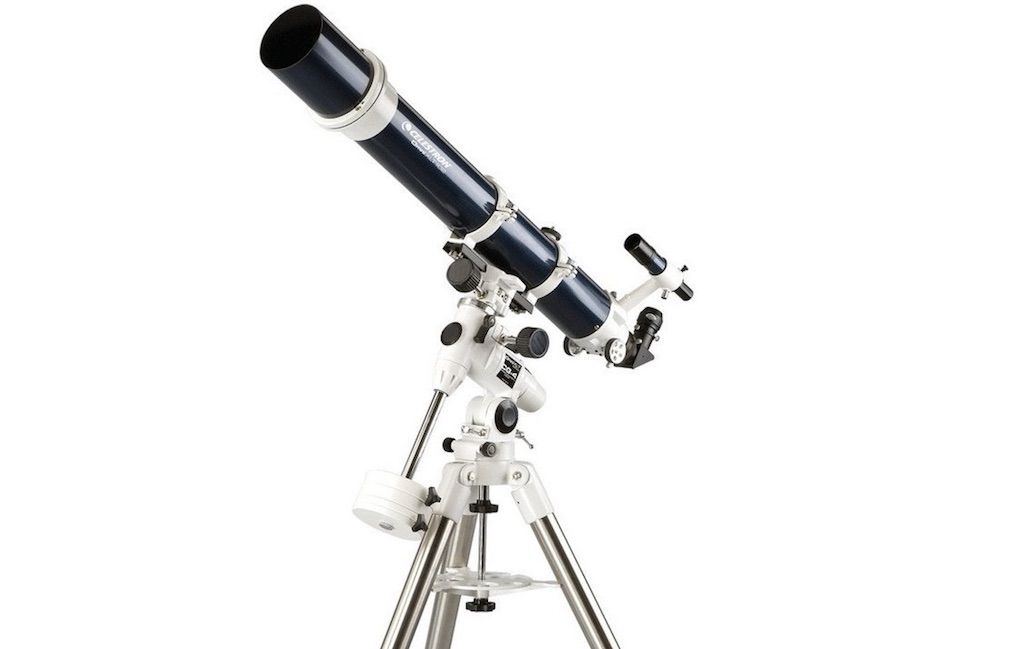
The Celestron Omni XLT 102 is aimed at intermediate-level skywatchers, particularly those who have mastered setting circles and know how to use right ascension and declination coordinates on the supplied high-quality CG-4 German equatorial mount.
The Omni XLT 102 features high-quality optics, painted with Celestron’s StarBright XLT coating to maximize light transmission. The optical system also makes use of aspheric shaping technology to minimize spherical aberration, a visual defect where incoming light is focused at different points.
As such, the Omni XLT 102, with its mix of aperture and f/10 focal ratio, is able to produce excellent views of the planets, from Jupiter’s atmospheric bands and moons, Saturn’s rings and craters on the moon, showing great contrast between areas in shadow and those bathed in daylight. While there is a slight amount of color fringing, views through the optical system are outstanding.
The refractor comes with a 25 mm eyepiece, 1.25-inch star diagonal, heavy-duty stainless steel tripod, accessory tray, spirit level, Starry Night Special Edition software and a 6×30 finderscope.
It looks like the Celestron Omni XLT 102 is out of stock in the U.K. Try these great alternatives instead:
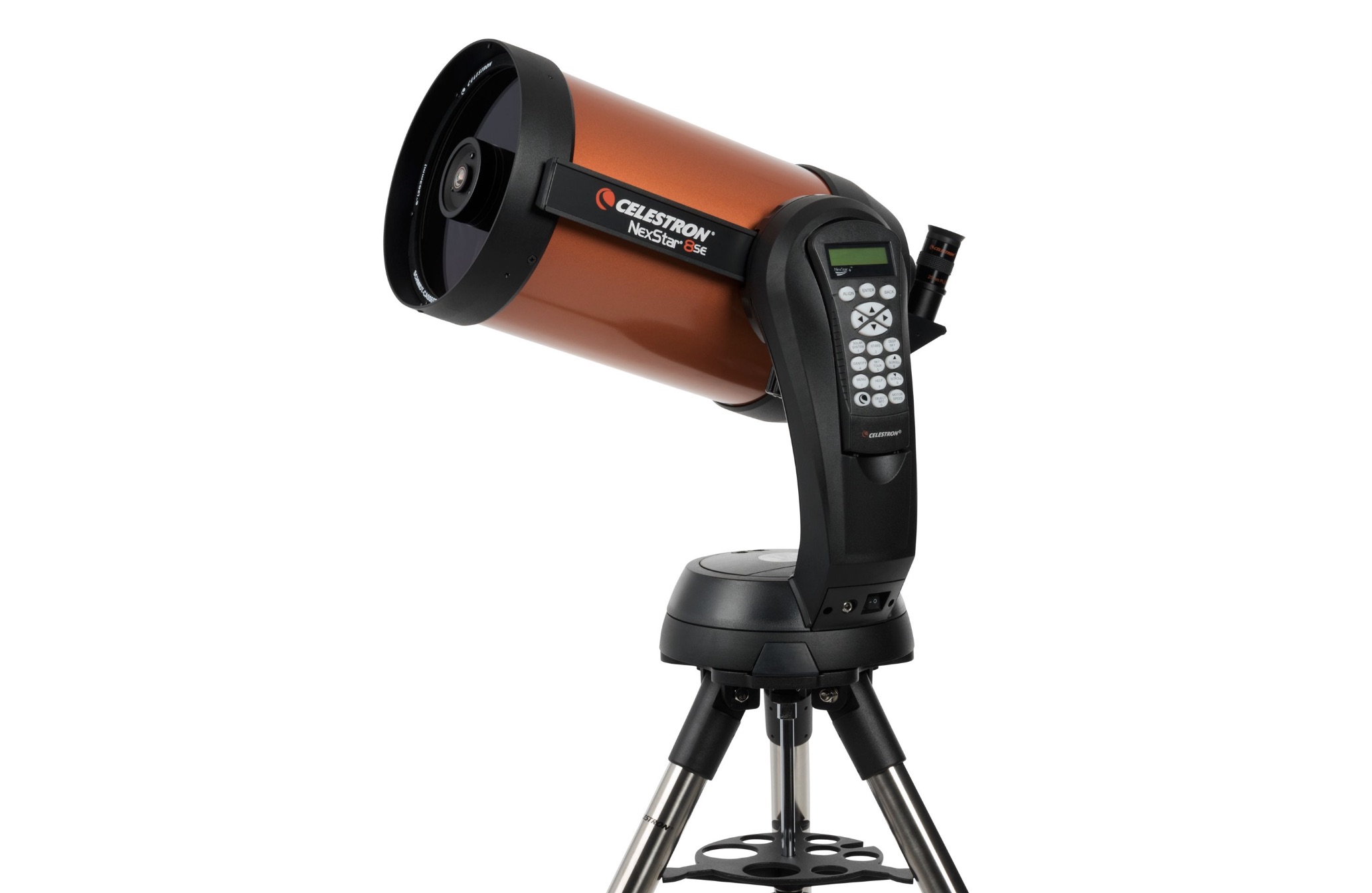
When you pay big money for telescopes, you’re usually guaranteed to get exceptionally high-quality optics that provide incredible views of a variety of astronomical targets.
Celestron’s NexStar 8SE certainly fits into this category, earning itself the title of the “world’s most beloved telescope”. Featuring a StarBright XLT optical coating, spectacular views of the planets and moon can be had and with excellent contrast and clarity: Jupiter and its moons along with Saturn and its rings are particularly breathtaking through the optical system. No chromatic aberration — or color fringing — can be seen around bright targets and, what’s more, very good views of the deep-sky objects are within reach of the eight-inch (203.2 mm) aperture.
With telescopes of this price and calibre, few eyepieces are included if any at all — it’s expected that the user will want to use their own, or purchase specific eyepieces to suit their needs. A 25 mm, offering a magnification of 81x, is supplied with the NexStar 8SE. A carry case for the optical tube assembly (OTA), stainless steel tripod, StarPointer red dot finderscope and 1.25-inch star diagonal are also thrown into the price.
If you prefer your telescope to slew to targets at the touch of a button and can’t decide on what to observe during any given night, the Celestron NexStar 8SE offers a tour mode of the 40,000+ objects in its GoTo database. Alignment is also exceedingly simple thanks to the telescope’s revolutionary SkyAlign technology but be warned: the NexStar 8SE drains batteries quickly, so we recommend using an external power source for uninterrupted observations.
With its high-quality build, the NexStar 8SE is built to last. And for those who want to capture images of planetary targets and the rugged lunar surface, the f/10 focal ratio provides the perfect opportunity.
Best astrophotography telescopes
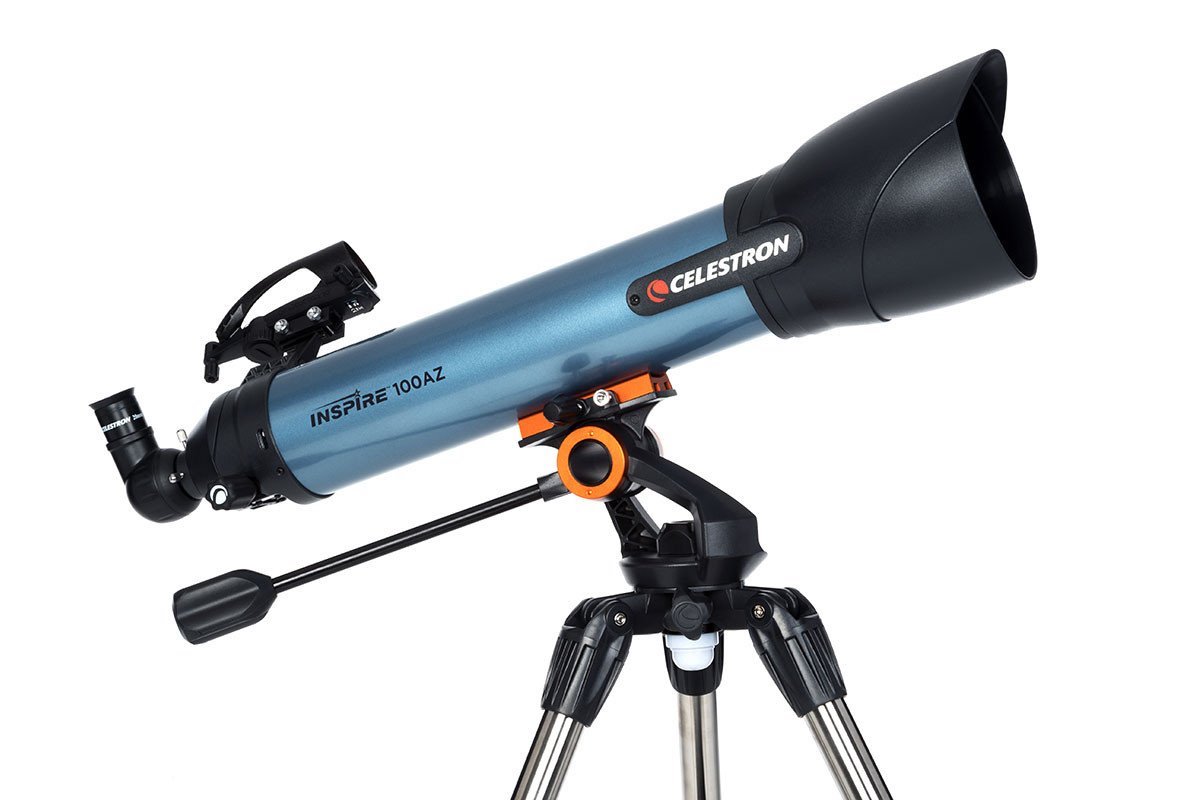
An excellent telescope for the beginner or those on a budget, the Celestron Inspire 100AZ is a great choice for those looking for a complete package that offers more in the way of accessories over most starter telescope bundles.
The Inspire 100AZ comes with a 90-degree erect image diagonal with a 1.25-inch fitting that makes the telescope suitable for terrestrial and celestial views, a pair of eyepieces (20 mm and 10 mm), red LED flashlight, accessory tray, StarPointer Pro finderscope and a smartphone adapter for basic astrophotography. Given the refractor’s focal ratio, the Inspire 100AZ is limited to short exposure photography.
A degree of false color and blurring in the field of view was detected during our observations. The latter is easily resolved with a careful selection of eyepieces, so we recommend investing in further eyepieces to make the most of the Inspire 100AZ’s optical system and to ensure that it does translate to your photos. False color, on the other hand, is to be expected in telescopes at this price point but it did not ruin the experience.
We are particularly impressed with the overall build of this refractor — the StarPointer is a pleasant surprise since it’s able to pick out faint stars under moderate light pollution for an accurate experience in hopping from one target to another.
Related: Celestron Inspire 80AZ: Full review
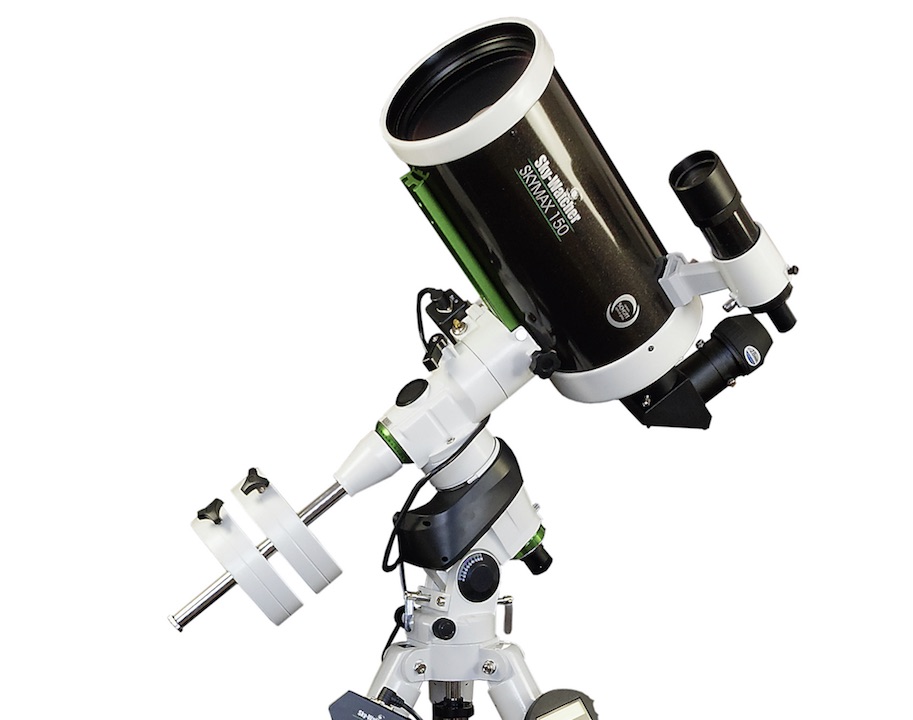
Sky-Watcher’s Skymax 150 is a great package for the price, with some models offering a high-quality equatorial mount for short-exposure astrophotography and long-exposure imaging. This well-constructed Maksutov-Cassegrain also comes with a single eyepiece with a focal length of 28 mm for a magnification of 64x.
Weighing in at 13.23 lbs. (6 kilograms), the Skymax 150 is suitable for most regular equatorial mounts — many makes and models will be able to take the load of both the telescope and extra accessories, including CCD or DSLR cameras, filter wheels and other such add-ons. For versatility in the type of mount you choose, a Vixen-style dovetail plate is supplied for the moderate price tag.
The Skymax 150’s optical prowess is outstanding, with no sign of optical distortion. The telescope is a great all-arounder, suitable for imaging everything from the planets to deep-sky galaxies and nebulas — and as you would expect for a telescope designed for giving great images. As an added bonus, the instrument is a breeze to use and accessorize.
The focuser is a dream to operate being lovely and smooth. The Skymax 150 keeps a good amount of fine-focus once it’s been found — vital for those long imaging sessions.
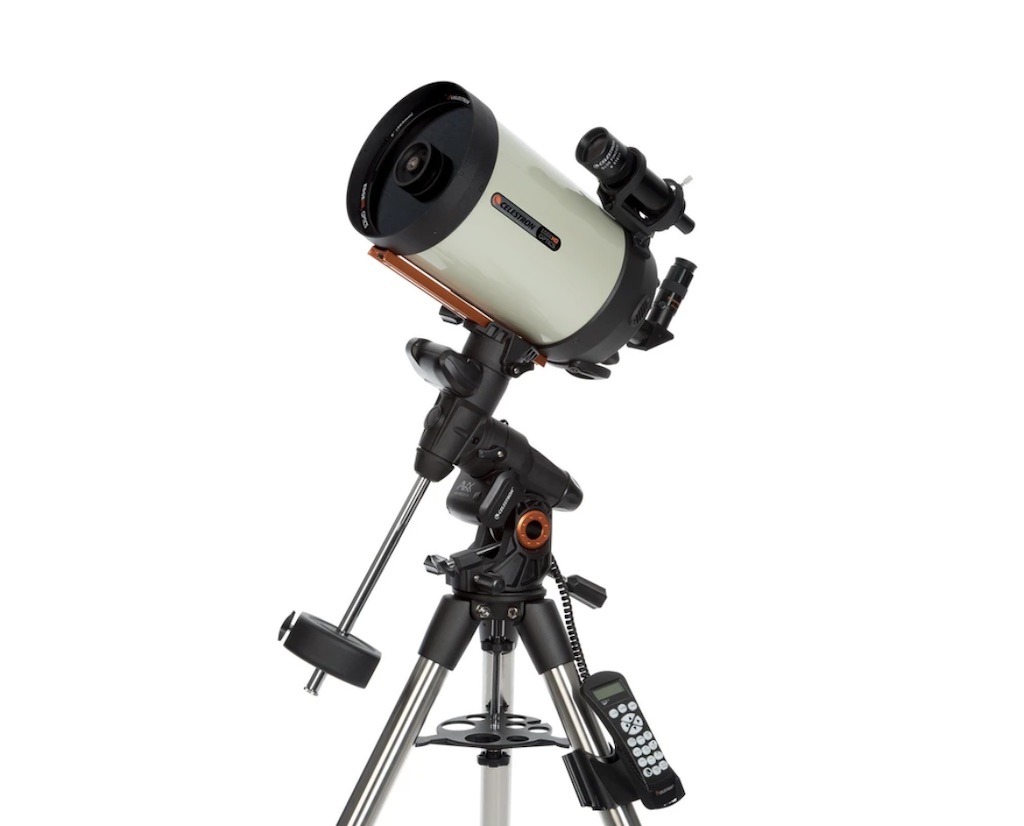
Celestron’s EdgeHD technology turns Schmidt-Cassegrain telescopes into high-quality astrographs with perfectly flat fields. The way that the Schmidt-Cassegrain optics focus light usually means that the focal plane — where the light comes to focus — is curved, but if you are imaging, your CCD camera’s sensor is flat. A curved focal plane on a flat CCD sensor results in field curvature, where stars at the edge of the field become blurry. An undesirable effect for astrophotographers.
The EdgeHD optics negate this, creating a perfectly flat field right to the edge of the frame for pinpoint sharpness right across the image. We are impressed with the optical performance that the Celestron Advanced VX 8 EdgeHD delivers, with views being crisp and clear with no optical distortion or false color.
As an added bonus, the optical tube assembly comes packaged with Celestron’s Advanced VX mount, which is tailor-made for imagers, capable of photographing across the meridian without needing to do a meridian flip. The setup also performs periodic corrections to remove errors when tracking objects and also comes with an autoguider port.
The Celestron Advanced VX9.25 EdgeHD can carry a load of 30 lbs. (13.6 kilograms) too, so for the tube and all your imaging accessories are fully supported. Also included is the standard NexStar+ hand controller, a 40 mm eyepiece and access to Celestron’s SkyPortal app and Starry Night Special Edition software.
It looks like the Celestron Advanced VX 8 EdgeHD is out of stock in the U.K. Try this great alternative instead:
Telescope buying advice
Telescope Glossary
Aperture: Diameter of the primary mirror or lens, which allows a telescope to collect light.
Field of view: Area of sky visible through the eyepiece.
Focal length: A telescope’s tube length. Short focal lengths offer a wide field of view and a small image.
Focal ratio: Also known as the telescope’s speed. Small focal ratios provide lower magnifications, wide field of view and a brighter image.
Magnification: Relationship between the telescope’s optical system and the eyepiece.
The aperture is one of the most important things to consider when purchasing a telescope, then you should next consider the focal length. The main thing to remember here is that bigger isn’t always better.
It really all comes down to the targets you are wanting to view. Shorter focal lengths, say of about 20 inches (500 mm), will provide a field of view for you to take in large areas of the Milky Way and showpieces such as the Pleiades (Messier 45) and Orion Nebula (Messier 42). Meanwhile, high-power objects such as the moon, planets or double stars need a telescope with a longer focal length of about 80 inches (2000 mm).
If you can’t really decide, then there are plenty of compromises between aperture and focal length but you must be willing to make a few trade-offs in terms of the weight of your instrument, the field of view and its “power”. Read on for what you can expect from the three major kinds of telescope: the refractor, reflector and the catadioptric.
Refractor telescopes
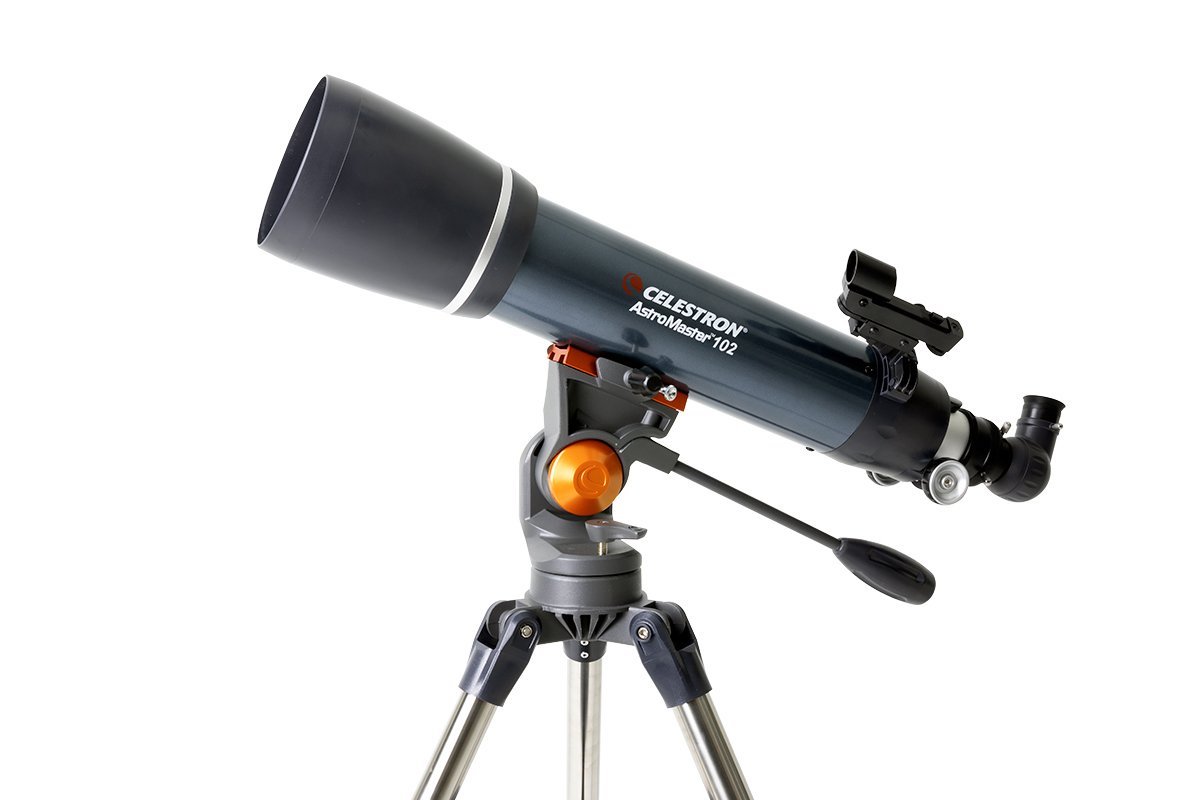
As their name suggests, refractors bend (or refract) the light that they gather to give you a view of your astronomical target. As telescopes go, they have a fairly straight-forward assembly and consist of a main objective lens at one end that focuses light through to the other.
Intuitive to use, the refractor is often a popular choice of instrument for novice astronomers since they require little maintenance and are usually affixed to the simple alt-azimuth mount, which allows the skywatcher to slew from left to right and up and down in order to locate a desired target. Being easy to use means that these telescopes are also simple to manufacture, making them cheaper to buy with price points increasing with aperture size.
Refractors are particularly good at given highly magnified and high contrast images and, because of this, are ideal instruments to use when looking at solar system targets such as the moon and the planets. The best refractors usually have an aperture of two inches (60 mm) or more and will provide reasonable views of astronomical objects. If you’re looking for a larger aperture, then a three- or four-inch (80 mm to 90 mm) will suit you best.
The drawback of a refractor is that they can suffer from chromatic aberration, also known as color fringing. When a single lens doesn’t focus all of the colours emitted from a target object at the same point, bright objects such as the moon, Venus or Jupiter usually have a colored halo around them. To reduce this problem, many refractors are manufactured as achromatic or apochromatic (also known as Extra Dispersion (ED) telescopes).
The achromatic refractor is cheaper than the apochromatic refractor and, combined with its efficiency, is often the type of telescopes that novice astronomers go for. Even if you decide to go for the more expensive achromat, you’re still likely to get a stubborn degree of purple fringing around some targets.
Unless you’re a seasoned skywatcher and you can afford to go for the more expensive apochromat — which corrects for such an effect by using exotic glass for the lenses — this degree of color fringing will not ruin your observing experience to any great extent. If you do decide to go for the expensive option, then you will be stunned by the views you will get through these excellent telescopes.
Be warned though: you might find that some apochromats come without a tripod, something that you’ll have to buy separately along with any accessories — so be sure to choose wisely.
Reflector telescopes
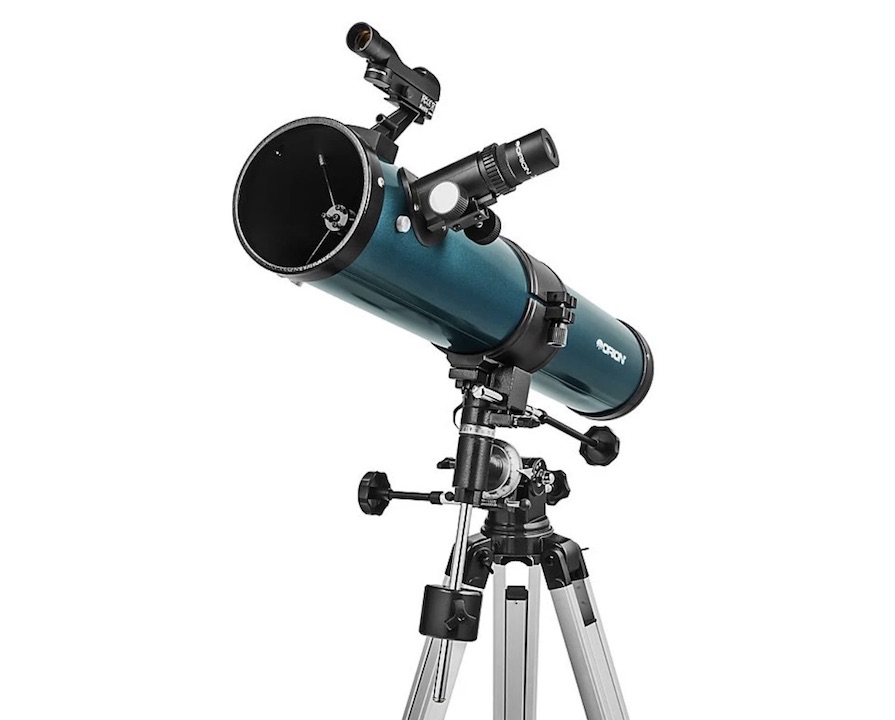
There are two common types of reflector telescope — the Newtonian and the Dobsonian. However, the way these instruments operate is exactly the same — they both use mirrors to reflect light to create an image of the object you’re looking at.
The Newtonian telescope is made up of a curved-light collecting mirror, which can be found at the tube’s base. The light that then hits this mirror is reflected back to the front of the tube, where a smaller flat mirror — orientated at 45° — brings light to the observer who can then see their chosen object.
The Newtonian can be found on alt-azimuth mounts, but you shouldn’t be too surprised to find this type of reflector is more popularly affixed to an equatorial mount, allowing the telescope to follow the rotation of the sky while being aligned with your hemisphere’s celestial pole. This reflector is a favourite in the amateur astronomy community due to their versatility by being able to observe a wide selection of astronomical targets and allow for astrophotography. With Newtonians, you can also buy a large aperture for less money — for instance, an eight-inch (203.2 mm) reflector would cost you less than a refractor with the same aperture, allowing you to get much more value for your money.
On the downside, the Newtonian doesn’t come hassle-free, especially when it comes to maintenance. You might find yourself having to have optical mirrors realigned as well as the mirror’s surfaces repainted since they can eventually become tarnished. If you choose to go for a reflector of this sort, then you should always choose one which has mirrors with a protective coating — these will last longer.
Some beginners to the hobby of astronomy might find setting up and using an equatorial mount tricky and that’s where the Dobsonian comes in. These telescopes give the capabilities of a reflector without the complexities an equatorial mount will bring since it employs an alt-azimuth mount. Dobsonians are very simple to use and can be pulled into orientation when looking at astronomical objects with ease. If you’re not confident in navigating your telescope though, then GoTo or computerized Dobsonians and Newtonians are on the market — but at a higher cost.
Whatever reflector you choose, these telescopes are excellent for low-magnification targets such as galaxies and many types of nebulas.
Maksutov-Cassegrain and Schmidt-Cassegrain (catadioptric telescopes)
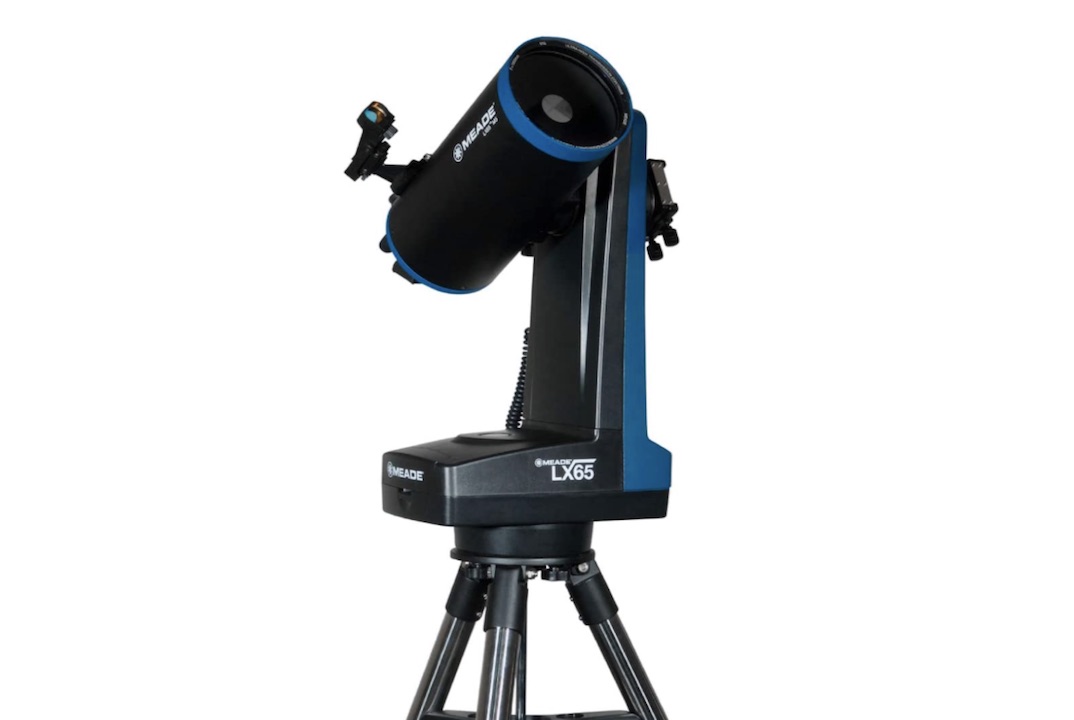
In order to take the best parts of the reflector and refractor, telescope manufacturers introduced the Schmidt-Cassegrain and the Maksutov-Cassegrain. These catadioptric telescopes generally correct any problems that are often experienced by reflectors and refractors.
The Maksutov-Cassegrain corrects the problem that the reflector experiences — an aberration effect called “coma”, which can make objects look distorted and appear like they have a tail. This effect is reduced or banished with the combined efforts of a mirror and a corrector lens. The Maksutov is ideal for beginners or for those who don’t have the time (or funds!) to complete any extensive maintenance on their instrument since the tube’s optics are sealed off.
This catadioptric is very robust and is also the ideal family telescope. Packed into its short optical tube is a system that allows you to target higher magnification objects such as the planets, moon and double stars. You’ll be able to pick up a Maksutov for a very good price and, if you struggle to find objects and your way around the night sky, then both this type of catadioptric telescope and the Schmidt-Cassegrain can be found in abundance and equipped with a GoTo system.
What you get with a Schmidt-Cassegrain is very similar to the capabilities of the Maksutov. It will allow you to make general observations of planetary targets and stars. It is also possible to expand the telescope’s field of view with the help of corrector lenses, providing you with the opportunity to view a wide selection of astronomical targets.
The catadioptric telescope is also suitable if you want to try your hand at astrophotography but combine this with their marked improvement on your standard telescope and you should expect to see a substantial rise in cost in comparison to standard reflectors and refractors.

